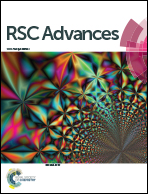Facile preparation of self-healing waterborne superhydrophobic coatings based on fluoroalkyl silane-loaded microcapsules
Abstract
Superhydrophobic surfaces have attracted tremendous attraction because of their novel aspects of surface physics and important applications ranging from self-cleaning materials to microfluidic devices. However, most artificial superhydrophobic surfaces easily lose their superhydrophobicity under natural sunlight irradiation, physical rubbing or organic contamination. Here, fluoroalkyl silane (FAS)-loaded microcapsules, photocatalytic TiO2 nanoparticles and FAS modified SiO2 nanoparticles were mixed with waterborne polysiloxane resins to obtain waterborne self-healing superhydrophobic coatings. Superhydrophobic surfaces were formed by casting the coatings on the substrates after UV-irradiation and could sustain their superhydrophobicity even after 360 h accelerated weathering test. Meanwhile, the coating was durable enough to withstand water blasting and the attacks of strong acid or basic solutions without apparently changing its superhydrophobicity. More importantly, after being mechanically damaged or contaminated with organics, these coatings could restore their superhydrophobicity under UV light. All these characteristics ensure that the coatings have excellent long-term superhydrophobicity for outdoor service.


 Please wait while we load your content...
Please wait while we load your content...